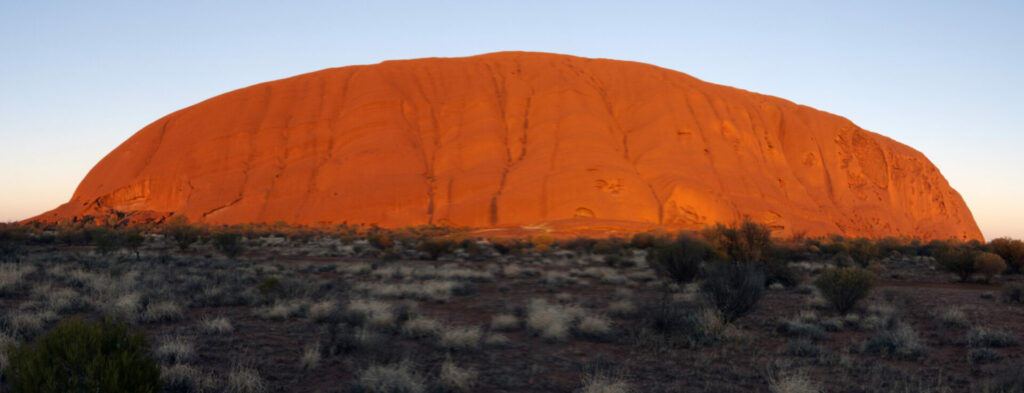Uluru Base Walk NT (10.6 km)
NT
Nearest Town
Yulara
Starting Location
Mala carpark
Finish Location
Mala carpark
Best Time to Travel
Year round but start early and finish by 11:00am in the hotter months to avoid the excessive heat
Uluru Base Walk Summary
This would have to be one of the Australia’s most iconic walks with this great stone monolith jutting out of the ground and dominating the landscape as you approach. I have had three ‘spiritual’ moments in my life and my visit to Uluru was one of them. My visit had a physical impact on me and the best way I can describe it is was the sense of raw power being radiated from the rock itself which I could feel on the entire walk. I have talked to others who having visited Uluru, have had similar experiences.
Most Australians and many overseas visitors will make a visit to Uluru at some stage in their life. The walk itself around the base of the rock (formerly known as Ayers Rock) is just on 10.6 km on a flat, well formed, compacted sandy path. You can do parts of the walk if you don’t have the fitness level but for those who want the full experience allow about 2.5-3 hours.
Without exception everyone wants to see sunrise on Uluru and the colour changes are spectacular so bring a decent camera and lots of capacity to take photos. A wide angle lens is also a must.
Many people forget that the Australian dessert gets very cold and on our trip in July the night time temperature was getting down to zero degrees celsius with the day time temperatures reaching around 23 degrees celsius, and this was mid winter. Temperatures in December and January can reach as high as 40 degrees celsius during the hottest part of the day so if you are traveling at that time of the year, start the walk at sunrise and finish by 11:00am at the latest to avoid the worst of the heat. Whatever time of the year you walk, come prepared for the temperature change and bring plenty of water.
The top of Uluru is 348 metres high and while it used to be possible to climb the rock, on the 26 October 2019 the summit climb ceased.
My next visit to Uluru will be during the rainy season. Just look online at Uluru when its raining as it’s a sight to behold.

Uluru Panorama image at sunrise on the rock. This image was taken one the base walk but most will will take this shot from a dedicated viewing area. The colours change a the sun rises and the image above hasn’t been touched up, that was just the colour at that time

While the sunrise is a must see, Uluru at dusk is also very spectacular and the colours become a deeper purple as the darkness descends

Walk signage

Even in death there can be beauty

Looking up at the rock is pretty impressive

No massed produced seating here. Take some time to sit and take in the scenary

Fuluru (fake Uluru/False Uluru). Driving towards Uluru tourists often think ‘Fuluru’ (also known as Attila and Mount Conner) is what they came to see
Getting There

While most people will drive or get a tour bus to Uluru from Alice Springs the option exists to get a flight. Unless you are pushed for time go by road and drive past Watarrka (Kings Canyon)
Things to Know
- Phone: There is variable phone signal (Telstra)
- Water: You need to bring your own water
- Toilets: There are toilets located at the visitor centre
- Trail: This is a circuit walk
- This trail consists of formed track which is accessible to all hikers
- As you walk around the rock there is signage asking you to avoid going closer and/or taking photos in certain areas due to cultural reasons
- Dogs: No dogs allowed
- Camping: Camping only allowed in designated campsites on the edge of the park
- Other:
-
- The climb to the summit of Uluru is now closed
- There is a 3 day park entry fee of $38 which is valid for three days (as at 21 August 2022)
- Most travellers want to see Uluru at sunrise so this means an early start. This early start works well as you don’t want to be out and about during the hottest part of the year and ideally want to finish the walk by lunchtime
- If you travel during the wet season you may be lucky enough to see Uluru during a rainstorm
-
Disclaimer
This walk was undertaken by the team from Australian Hiker